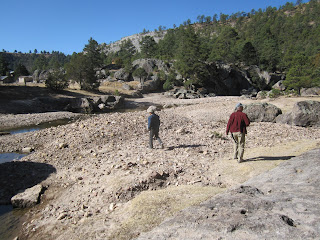"Built by Olympic Narcos" he says. They were arrested at the Sydney Olympics in 2000 and the name stuck. The lodge where we stop is lowly in comparison. The Sierra Lodge has no electricity but there are oil lamps and fireplaces in the rooms leading off the veranda and it is set in a river valley, far away from the noises of civilization. Pines cover the mountain slopes.

We follow the river, crossing a rickety bridge that has me concentrating hard to keep my cool. The river is at drought level and runs in channels through wide expanses of sand and stone. There are pools of clear, ice cold water, frozen in places. Large boulders and areas of grass give a pastoral feeling.
We see the colourful Western Blue Bird and Mexican Blue Jay and the occasional bright skirts of Raramuri women.
The Cusarare falls are high and delicate with such a small quantity of water spraying downwards, it is easy to cross the shelf above them. The water only inches deep with many dry stepping stones.
Lori has a charming interchange with two young girls who play a hiding game with their blanket. I buy a nesting basket and a simple applique bag to hold my camera. Further along the path I stop to buy a tiny scorpion exquisitely crafted from copper wire. A woman knitting nearby is so absorbed watching us, she drops a ball of wool which bounces down across our path and down again out of sight. She laughs and we can't help ourselves. Shared laughter is such a magical connection.
We eat our lunch of burritos in front of the lodge overlooking the river while a very hairy pig snuffles his way below us. A Canyon Wren hops in and out of the eaves.
Arriving in the village of Cusarare, we hear the sounds of someone practicing the electric guitar. A peach tree blossoms outside the guitarist's wooden home. Houses are simple and widely spaced between corn fields ready for planting. Low stone walls and wire fences enclose the fields. There is no graffiti and very little garbage.
We see chickens, sheep, goats, pigs and horses. There is a door and window set in a rock face but no other signs of cave dwelling. Noel point to a sports field with bleachers and tells us basketball is very popular. He tells is alcohol and smoking are not part of everyday life.
An old man with one leg is sitting on the ground splitting short logs. He has carved spoons out of Madron, smooth and with a deep bowl. What a pleasure to use such a utensil. Lori and I each buy one. As we enter the church, Noel tells us the Raramuri are nearly all Catholic. There are no pews. The congregation prefers to sit on the wooden floor. The whitewashed walls are decorated with designs picked out in clay. Front and centre is Virgin of Guadalupe over top of a huge Mexican flag.

The caretaker brings out his chapareke. This is a stringed instrument which is plucked and blown, creating a soft haunting Jew's Harp-like sound. One of the melodies he plays is called The beautiful blue sky.
The Valley of the Monks is a clue that though as Noel says, the Raramuri are Catholic, there has been a great deal of whitewashing native spirituality. These rocks bare no resemblance to monks, other than what is common to all males. We climb, wondering how these formations came about.
Driving to another set of rock formations, these like mushrooms, we encounter an ancient couple on a horse drawn cart. Without a tooth in their heads, their smiles are utterly content. The horses' halters are lovingly padded with coloured fabric. We long to photograph these lovely old people, but cannot. Noel finishes his conversation with them and drives on, explaining the case of coke the couple have on the cart.
"Raramuri love to watch basketball, drinking coke with peanuts dropped in the bottle." He laughs affectionately. Noel's wife is Raramuri and he himself is of mixed ancestry. He tells us he worked as a porter for the railroad when he saw her selling baskets. They ran away together the day they met.
I ask what her parents thought about that. His reply:
"They got used to us."
We stop at a cave where a woman has crafts for sale. Noel tells us she lives in the cave, but I am not so sure. There are houses round about and this has not even a hint of the simplest form of comfort. Perhaps it was once used, but now it seems to be the place where the chickens roost and farm utensils are stored. No doubt it brings a steady income from tourists who are unlikely to clamber down the canyon slopes to inspect a family home. We leave our donation in the basket provided and return to Creel.
I wonder how the Raramuri can ever resist the pressure of Western Civilization. Noel tells us that the Mennonites in Chihuahua like to hire Raramuri men as labour on their farms at times of peak work, and both groups like each other. I picture the Mennonite women I have seen in Manitoba with their simple black bonnets, and long dresses, and think perhaps their friendship gives hope to Raramuri survival.







